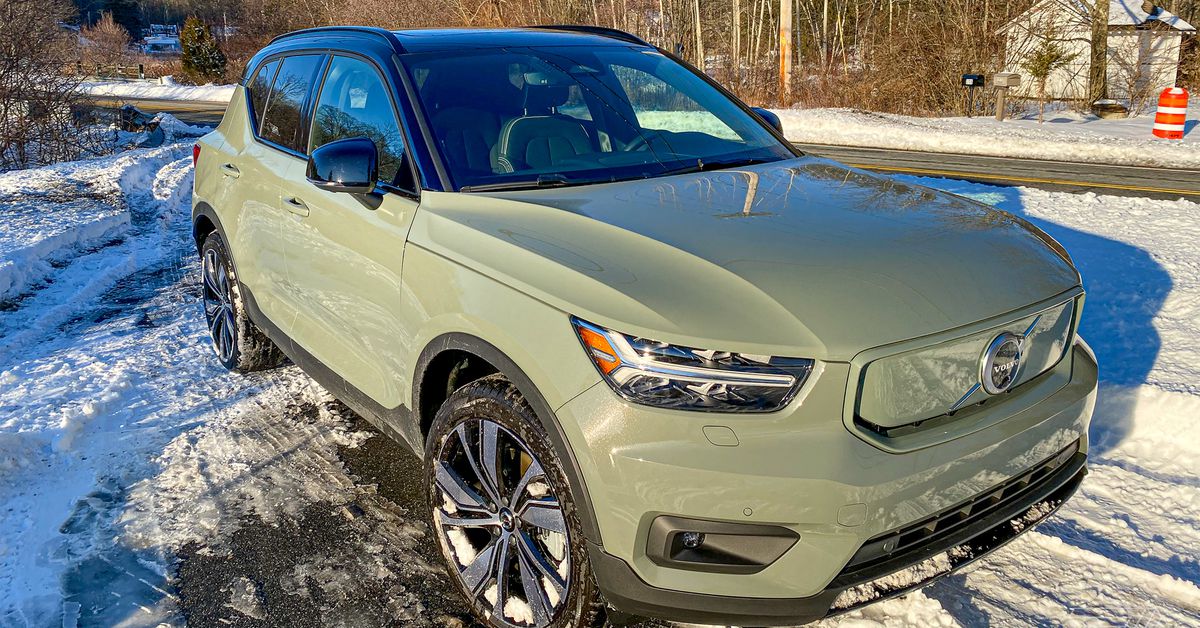AMD RDNA 4: Everything we know about the RX 8000 series
AMD's next-gen RDNA 4 graphics cards are coming soon, but they're still shrouded in mystery. Here's everything we know about RDNA 4.
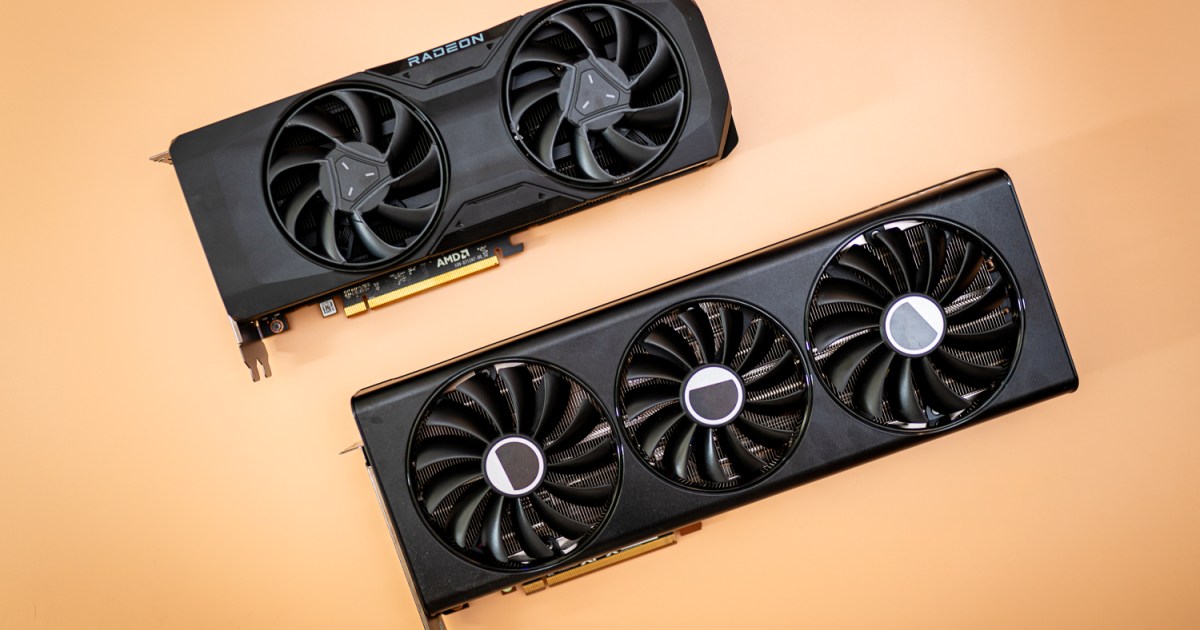
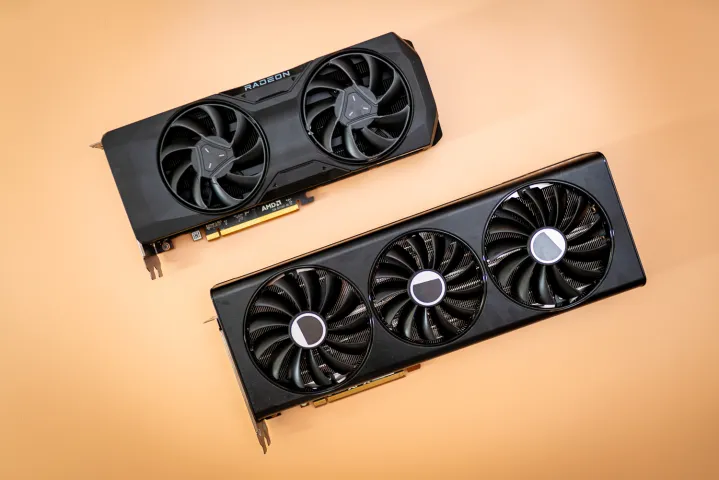 Jacob Roach / Digital Trends
Jacob Roach / Digital TrendsAMD’s RDNA 4 graphics cards (also referred to as the Radeon RX 8000 series) are already on the horizon, but they’re still a bit of a mystery. Fortunately, while AMD is still keeping quiet about its next-gen GPUs, various leakers break up that silence with plenty of rumors and tantalizing speculation.
Most likely set to launch this year, RDNA 4 GPUs may give Nvidia a run for its money, but will they be able to compete against some of the best graphics cards from the upcoming RTX 50-series? This is one of the few things that leakers all agree on, and we’ll tell you all about it in our full roundup of RDNA 4 news below.
RDNA 4: Specs
| AMD RDNA 4 | |
| Process node | TSMC N4P |
| Architecture | RDNA 4 |
| Chip | Navi 48, Navi 44, Navi 43 (?) |
| Memory type | GDDR6 |
| Maximum bus width | 256-bit |
| Maximum clock speed | 3GHz-3.3GHz |
Everything we know so far about the specs of AMD’s RDNA 4 comes from leaks. Some of the information overlaps between various sources, but when it comes to the specs, most of the intel comes from Tom of Moore’s Law Is Dead on YouTube. So far, the YouTuber predicts that AMD will only release RDNA 4 in two configurations: Navi 48 and Navi 44.
The one thing that most sources are clear on and have been talking about for months is that AMD’s next-gen GPUs won’t have the specs needed to match Nvidia’s high-end GPUs, like the RTX 5090. AMD is aiming at the midrange sector, which is evident in the rumored specs for both chips.
Navi4 lineup will not have any high-end GPUs
Think of it like RDNA1 or Polaris generation.
— Kepler (@Kepler_L2) August 4, 2023
According to Moore’s Law Is Dead, the Navi 48 will be AMD’s flagship for this generation, and it will possibly be found in an RX 8800 XT GPU. Initial estimates pin this GPU as having a 256-bit interface, with GDDR6 memory clocked at 20Gbps. It’s also possible that it might come with a 192-bit bus, as has been mentioned by some leakers. The Navi 44 GPU is rumored to sport a 128-bit memory bus and a significantly smaller die.
The choice to use GDDR6 instead of GDDR7 may seem surprising, seeing as Nvidia’s next-gen GPUs are said to be using the faster and newer GDDR7 standard. Moore’s Law Is Dead speculates that AMD may have initially planned to use GDDR7 memory in the — now reportedly canceled — high-end portion of the lineup, which is referred to as Navi 41 (or Navi 4C and Navi 4X) and Navi 42. The Navi 41 would’ve been the successor to the RX 7900 XTX if it became a reality. However, the midrange to entry-level cards are all said to sport GDDR6 memory.
Initial, highly optimistic estimates said that RDNA 4 might reach 3.5GHz, but those predictions have now been adjusted to a more reasonable 3GHz to 3.3GHz on overclocked models made by AMD’s partners. Even then, this is a massive game clock increase over the RX 7900 XTX, which has a frequency of 2.3GHz.
A few months ago, Moore’s Law Is Dead spoke about a possible Navi 43 GPU, which is also no longer being mentioned. As per the rumor, the Navi 43 was said to sport 64 compute units (CUs), with the Navi 44 having 32 CUs. However, even the source of the leak warned that these specs were uncertain.
The rest of the specs are still unknown at this stage; there’s been no mention of the number of AI accelerators, ray tracing accelerators, or even the amount of VRAM. We’ll have to wait until we get closer to the release date.
RDNA 4: Pricing and release date
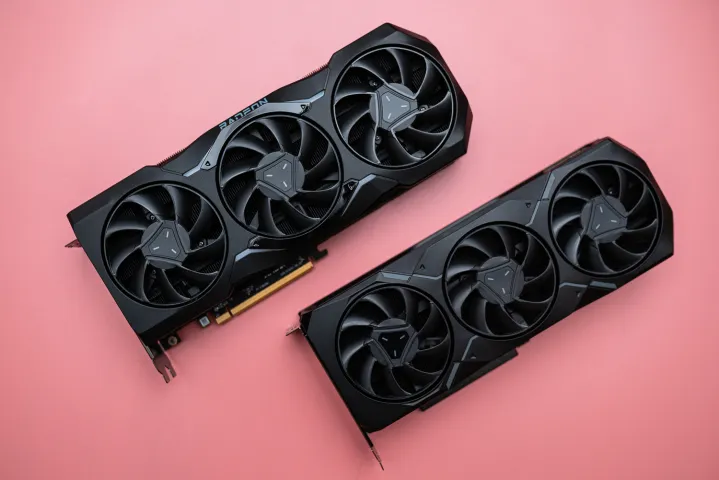 Jacob Roach / Digital Trends
Jacob Roach / Digital TrendsOut of all the GPUs that might come out this year, AMD’s RDNA 4 is the most likely to actually hit the shelves in 2024. Even then, there’s still a lot of uncertainty, and the rumored release dates span three different quarters.
Most leakers point to a release in the second half of 2024. One source quoted by Moore’s Law Is Dead claims that RDNA 4 will be ready to launch in the fourth quarter, but there’s a slim chance it could be released a little sooner. It’s also possible that it might be delayed until the first quarter of 2025.
Another source said that the driver development is going well and that RDNA 4 is already ahead of where RDNA 2 was at around the same time in 2022. This leaker claims that AMD might tease RDNA 4 during Computex in June and then release it in the third quarter.
 Moore's Law Is Dead
Moore's Law Is DeadBased on the quotes, it seems that AMD may be in no rush to launch RDNA 4 as soon as possible. Nvidia’s RTX 50-series may not be much of a threat, given that Team Green is likely to open with the RTX 5090, which isn’t AMD’s target market this time around. With that said, we’re likely to see a couple of desktop GPUs first and then a laptop launch later on — assuming they’re easier to get in the next generation than in this current one.
Although AMD may not win in performance, leakers speculate that it might adopt an aggressive pricing strategy this time around, beating Nvidia in terms of value. Rumor has it that the Navi 44 GPU might sell for under $400, while the flagship Navi 48 (RX 8800 XT?) could be priced around $500. That’s a highly competitive price point that worked out swimmingly for AMD with the RX 7800 XT, so this makes sense, but everything is still uncertain. We might see as much as a 30% improvement in terms of price to performance.
RDNA 4: Architecture
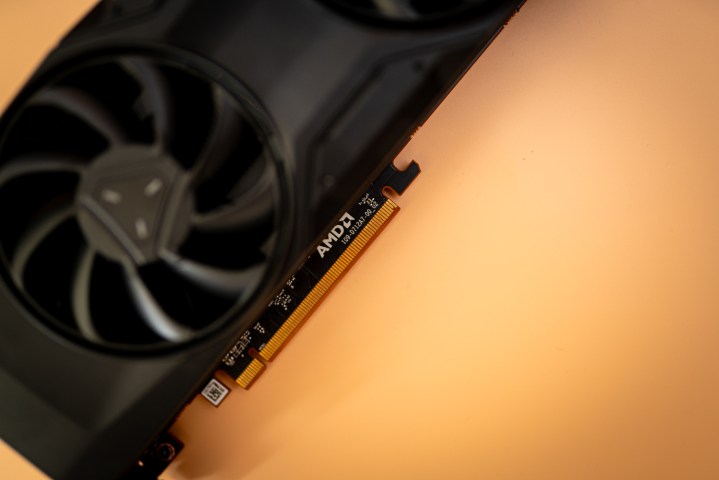 Jacob Roach / Digital Trends
Jacob Roach / Digital TrendsNavi 44 and Navi 48 are reportedly built on TSMC’s N4P process, which, as Moore’s Law Is Dead notes, will be single digits better than the node found in Nvidia’s Ada Lovelace GPUs. Navi 48 has an estimated die size of 300 to 350 mm², while Navi 44 is a lot smaller at below 210mm², which is close to the same size as the die inside Nvidia’s RTX 4060 Ti.
The naming scheme for these chips is a departure from previous generations. Usually, AMD’s flagship chip was also the one with the lowest number, such as Navi 31 in RDNA 3. This time, we’re getting the Navi 44 as the lower-end GPU and the Navi 48 as the top graphics chip. Given the rest of the rumors, this kind of tracks — AMD is said to name its chips based on the order of development, so if it canceled the initial Navi 41 chip, the Navi 48 may have started development later.
When it comes to architecture, the whispers we’ve been hearing over the past year or two have done a complete 180 compared to early leaks — all thanks to mentions of multichip module (MCM) architecture in RDNA 4. This means combining multiple dies on the same chip, which we’ve already seen in some of AMD’s top CPUs.
Such leaks aren’t anything new at this point. Some rumors first indicated that AMD might switch to MCM in RDNA 3, which obviously didn’t happen. Initial reports on RDNA 4 said the same, but over the past few months, leakers slowly pulled back from that theory. Now, both Moore’s Law Is Dead and RedGamingTech on YouTube say that we’re looking at a monolithic die. The moving goalpost has now shifted to RDNA 5, which is said to introduce bigger changes, including MCM architecture. It appears that we could have had MCM in RX 8000 series GPUs if not for the fact that the high-end variants were reportedly canceled.
However, we might still see some architectural improvements in RDNA 4. Hardware leakers have been vocal on the fact that AMD wants to improve the ray tracing performance of its GPUs, and RedGamingTech speculates that we might see adjustments to the geometry engine. Other sources also mention AMD’s drive to better compete in AI workflows and ray tracing.
RDNA 4: Performance
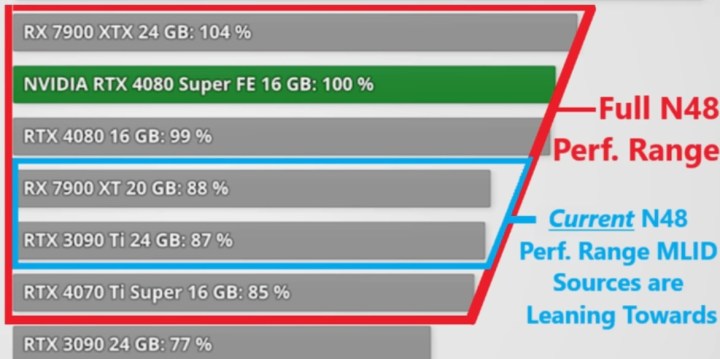 Moore's Law Is Dead
Moore's Law Is DeadIt seems that AMD won’t beat its own top GPU (Navi 31) this time around. The RX 7900 XTX is said to retain the lead in pure rasterization, but the new GPUs should improve ray tracing and have better prices.
Comparing the flagship RDNA 4 card to the rest of the competition tells a different story. Most sources estimate that the rumored RX 8800 XT should be close to the RX 7900 XT in performance. Moore’s Law Is Dead says that it’ll be around 10% slower than the RX 7900 XTX, putting it close to Navi 31 and Nvidia’s RTX 4080. It should outperform the RTX 4070 Ti Super by a small margin.
No, N31 will remain the flagship until RDNA5.
— Kepler (@Kepler_L2) August 5, 2023
The most optimistic outcome was that the Navi 48 GPU would be able to beat Nvidia’s RTX 4080 Super for around half the price, but it’s too early to get too excited. That would certainly be a big feat for AMD to achieve and a good way to beat Nvidia in 2024. Even if AMD can’t quite hit those numbers and only outperforms the RTX 4070 Ti Super, but prices the GPU at around $500, that would still be a great deal.
Meanwhile, the Navi 44 die (which could end up in an RX 8700 XT) is said to offer similar performance to AMD’s RX 7700 XT, but at a reduced price. Some sources pin it as an improvement over the RX 7600 XT, but a downgrade compared to the RX 7800 XT. Right now, it’s unclear whether AMD will release more entry-level GPUs in this generation.
RDNA 4: Ray tracing
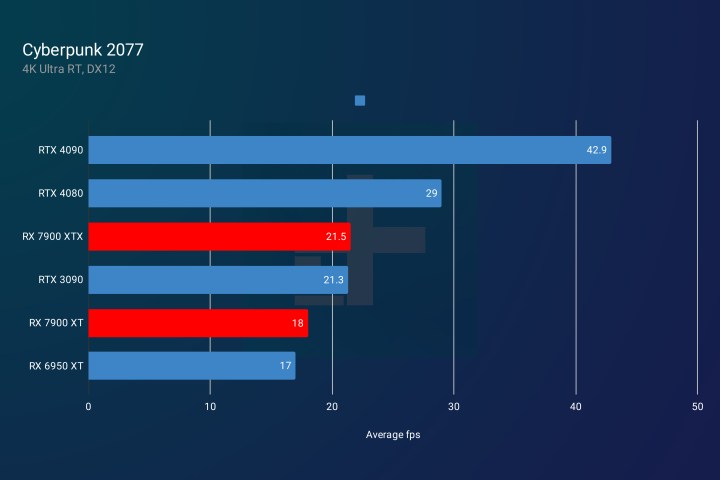 Jacob Roach / Digital Trends
Jacob Roach / Digital TrendsRay tracing is one area where Nvidia maintains a notable lead over AMD. This is no longer a universal truth the way it was in generations past, but it’s still true. A comparable Nvidia GPU can usually be counted on to outperform AMD when ray tracing is enabled, although the gap is wider in some games.
Improving ray tracing performance is something that a lot of leakers stress the importance of in RX 8000 series graphics cards. RedGamingTech claims that we’re looking at a boost of 10% to 30%, which is a wide range, but it’s still early days. However, Moore’s Law Is Dead says that his sources aren’t convinced that AMD will be able to beat Nvidia in ray tracing in RDNA 4 yet — the goal is to beat RDNA 3, with an uplift in ray tracing performance per compute unit.
While rumor has it that RDNA 4 will still be a hair slower than Nvidia in these workloads, it should offer a marked improvement over the previous generation. The Navi 31 GPU is said to outperform the Navi 48 in pure rasterization, but it may fall behind in ray tracing.
All of the above is still pure speculation, and the rumors about this generation have been shockingly scarce. We’ll have to be patient and keep our eyes peeled for more leaks as we get closer to the release date.

 BigThink
BigThink 











